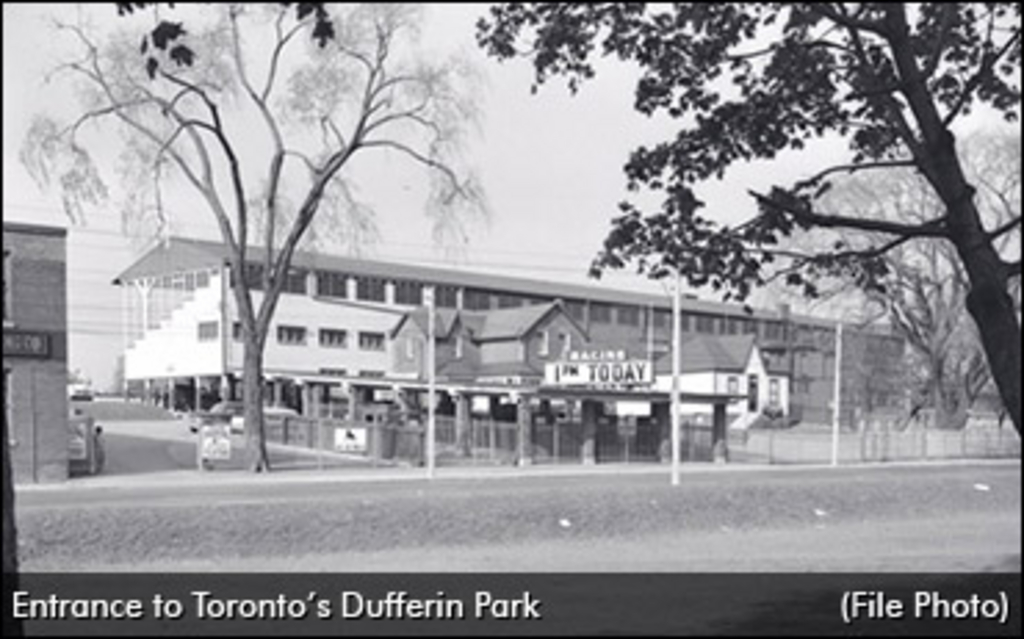
 In this week's Rewind Robert Smith recalls the once famous Dufferin Park in Toronto and its closure 60 years ago. This is the first edition of a three-part story.
In this week's Rewind Robert Smith recalls the once famous Dufferin Park in Toronto and its closure 60 years ago. This is the first edition of a three-part story.

This old photo shows the finish of a race at Dufferin Park taken in 1949. The track was nestled among a city neighbourhood on Dufferin Street between College and Bloor.
This month marks the 60th anniversary of the closing of the fabled Dufferin Park racetrack which was located in the west end of the City of Toronto. Its actual final day of harness racing was Saturday, March 19, 1955. Known throughout the racing world and elsewhere for its uniqueness and charm, it had been the acknowledged capital of winter racing for many decades. Most observers felt that life would never be quite the same for those who had come to know and love the place, both as fans or participants.
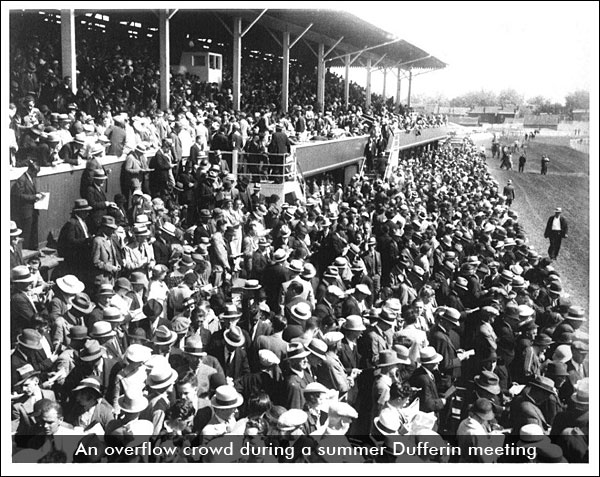
The track's closure marked the end of a run of 47 straight years of commercial racing at Dufferin; prior to that, it had served as a private race course operated by the Dennison family who had the property deeded to them from the Crown. In 1908 the track property, which consisted of 21 acres, was purchased by Abram "Abe" Orpen for a reported $4,000. Following the senior Orpen's death in 1937, his son Fred operated Dufferin and its sister suburban track called Long Branch. Upon its closure, which actually occurred in November of 1955 with a thoroughbred meeting, it was sold to a group headed by Toronto industrialist and sportsman E.P. Taylor for a reported $4 million. Its future usage would be the site of the proposed Dufferin Shopping Mall.
Some accounts glamourized the sale of the property saying that the entire payment was made in cash rolled out on a pool table intended to impress Mr. Orpen and dissuade him from a change of heart. This was undoubtedly an overdramatization as the transaction probably involved just a rather large cheque.
The elder Mr. Orpen was an interesting and intriguing figure. He was of Irish decent and a strict Anglican who first earned a living as a carpenter and later as a bookmaker at Toronto tracks. A generous giver to charity, he was said to have fed as many as 1,000 people a day in the early years of the depression when he set up emergency kitchens. It was also well documented that at times he came to the aid of horsepeople by paying their bills and tiding them over until their fortunes changed.
A further interesting aspect of his caring personality was well documented by more than one source, although not widely publicized. At times it was said that Orpen, and later his son, would receive phone calls from women whose husbands had lost their wages at Dufferin. The Globe and Mail's sports writer Dick Beddoes recalled that Orpen or someone from his staff would drive to the woman's house and deliver an envelope. The message was always the same "Here lady is what your husband lost at our track. We approve of gambling but not with the grocery money."
In the very early years of Dufferin, struggles among rival tracks and animosity between owners was commonplace. While Mr. Orpen was widely acknowledged for his philanthropic deeds, it was also known that he knew how to 'get business done' and was at one time said to be quite close friends with the likes of Al Capone.
Legend has it that he was once kidnapped for ransom and had his own way of handling the situation. He was driven to his bank where he withdrew $1,000 and did not raise the alarm. Additionally as part of the bargain, he refused to cooperate with the authorities in identifying the kidnappers.
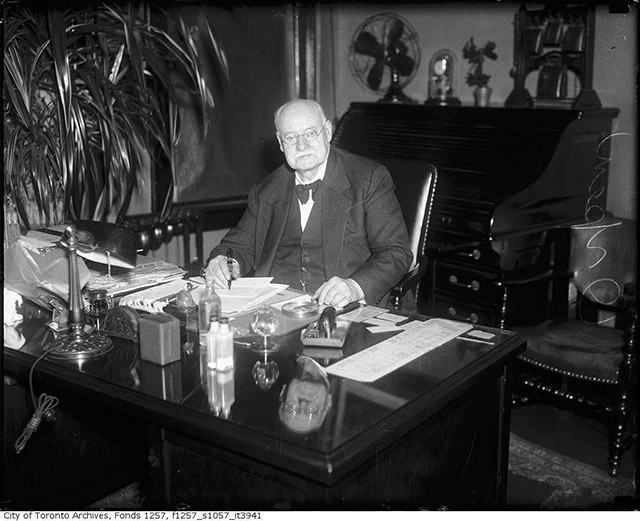
From a very small and humble start in 1908, Abe Orpen became the acknowledged dean of racing in Canada. Here he is shown in his office during the last few years of his lifetime.
Dufferin Park was truly a beloved place, a track with its own unique clientele who considered it their track. Lunch pails and working clothes were a common sight whenever races were held at 'Little Saratoga' as it was often called. It was a track that admitted people for free after a few races and it was not uncommon for folks to stop, watch a few races, place a bet or two and go on about their day. At the time of its closing, then-Track superintendent Tommy Anderson said in an interview, "We liked to think this was a track for ordinary people." For some reason people were just naturally drawn to Dufferin.
He also said, "But we had all kinds of patrons and on any given day you might see a Rolls Royce parked next to a Pre-wartime clunker." Dufferin never had a clubhouse and there was just one small reserved section in the wooden grandstand. While the facility was short on creature comforts it was long known for its tasty and wholesome food, served beneath the grandstand. For the princely sum of 50 cents, a hungry diner usually left well filled and equally satisfied. It had a reputation of being a very 'friendly' place where everyone felt at home.
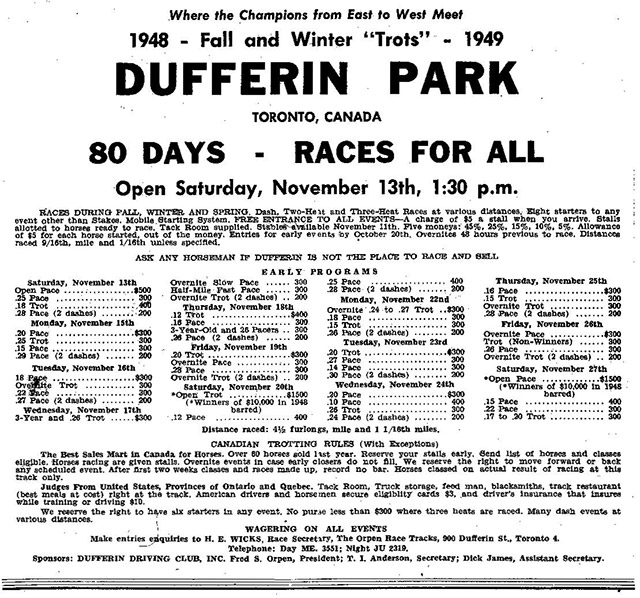
A couple of old 1940's ads follow, outlining the coming race season for Dufferin Park.
There were very few famous horses who ever raced at Dufferin. It just wasn't that type of place. An old joke of long standing said that owners of top horses feared that they "might twist a leg on a half-mile track." The track's strong suit and its long time reputation was that of being a great place for 'Bull Ring' horses. Perhaps not a glamorous term, but one that probably fit well. The management advertised that there would always be a class for every horse.
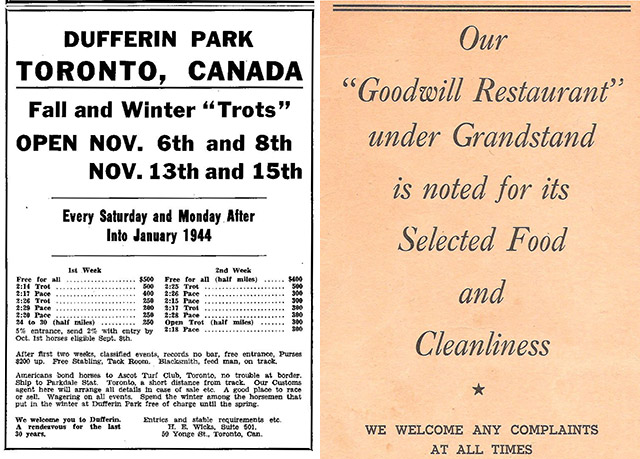
One unique part of the track was its infield. In the earlier days of racing, people were routinely allowed in the infield but in later years it was considered off limits. At Dufferin everybody was let in to that area and it was considered a prime spot.
While it did not say so, it was also home to virtually every so called 'character' possible. Toronto Star sports writer Milt Dunnell called Dufferin "cozy" and described an atmosphere rich with a sense of local community punctuated by the personalities who frequented the track. In many of his writings he fondly recalled "Centre Field Willie" further nicknamed "The Merchant of Venice" known for salvaging equipment at the track, refurbishing it and selling it again. According to Dunnell, "Centre Field Willie could sell a horseman almost anything from a rat trap to a broodmare." He was also known to supply a 'nip' to those in the crowd with a thirst quenched only by a beverage of alcohol base.
Many famous and not so famous horsemen competed at "The Dufferin" as it was frequently called. Among the cast of thousands who plied their trade at this memorable spot were many future Hall of Famers. Well known figures of past days like Joe O'Brien, Clint Hodgins, Vic Fleming, Nat Ray and "Hump" Morrison all raced over this iconic course. At one time ice racing was a popular form of the sport and attracted rather large crowds. In later years many more famous horsemen made their winter home at this fabled spot.
Upcoming editions of Rewind will carry more stories, pictures and 'tales' about the memorable old Dufferin Park.
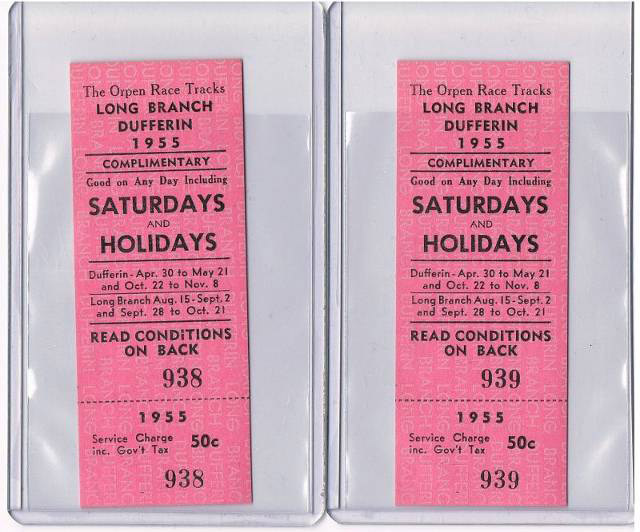
Admission tickets for Dufferin Park's final season. [From Tim Bojarski]


For Eric Sherban - Remember
For Eric Sherban -
Remember - The tracks were the only game in town in those days - No OTB, No live race streaming, No RPI and online betting and no competitive slots parlours, casinos and lotteries etc.
Also a large percentage of the population could remember when the milkman, the bread man, the coal man and the ice man all delivered with horses and there were still probably many that could remember when there was a horse in the stable and a buggy in the drive shed and not a car in the garage!
Where have all the crowds
Where have all the crowds gone? You can hear a pin drop in the grandstands now.
Sally Sue, a good race mare
Sally Sue, a good race mare which I owned and bred started her career at Dufferin. After a few starts I was very proud when the announcer said " Ladies and gentlemen this mare has been undefeated in her racing career." She went on to win 18 dashes that year.
Another great and whimsical
Another great and whimsical story! I wish I could "REWIND" to that part of my life (temporarily) and watch a few. But in those years I was only 3 or 4 years old living within a few blocks south. I wonder if my dad dropped by?
from Oct 26, 1955 Harness
from Oct 26, 1955 Harness Horse:
Dufferin Sale Cancels Winter Meet
Dufferin Park, where hundreds of horsemen from Canada and the United States have raced throughout the winter for more than 50 years, was sold recently by Fred Orpen to Toronto Racing Securities Ltd., for a reported $4,000,000.
The original sale price was reportedly $4,500,000, but was decreased by $500,000 when the prospective purchasers were reluctant to take over eight houses and a factory building on the Dufferin site.
The sale included both the Dufferin and Long Branch race tracks, and 10 racing charters, eight of which provides for both harness and running races and two that provide for harness races only.
In a statement concerning the purchase Toronto industrialist E. P. Taylor, head of purchasing group and Canada's leading Thoroughbred owner, stated that he hoped the Ontario jockey Club would take up the charters on the tracks after the purchase is completed and continue racing.
Racing was inaugurated at Dufferin soon after the turn of the century. At that time it was conducted on Saturday and Mondays only, with free admission on the latter day. Later the meeting was increased to three days a week, and then finally to a full six days. For the last several years a meeting of 100 days has been held each year between November and March.
Sale of the two race courses also means that Thoroughbred racing at both tracks will be discontinued at the end of the 1955 season.
In addition to its popularity as a winter racing site, Dufferin is also noted as a market where many horses are sold, purchased and traded during the meeting.
end of quote
from Apr 1988 Hoof Beats and Nat Ray Scrapbook:
Nat Ray's great and lengthy career, which spanned the next six decades, is fascinating. He managed to spread his talents across three major areas of horse racing. His fame not only included harness racing, but also major contributions to the annals of thoroughbred and steeplechase racing-a rare blend indeed. Racing scribes often referred to Nat Ray simply as "the man with the brilliant green jacket," a color which was predominant in his racing attire.
Ray left his native Canada in 1896 to begin a career in thoroughbred racing in the United States. He rode his first winner of note, a horse called Bob Neeley, in 1898 at Cincinnati for owner Abe Orpen, who was part of a great Canadian racing family that owned several racetracks.